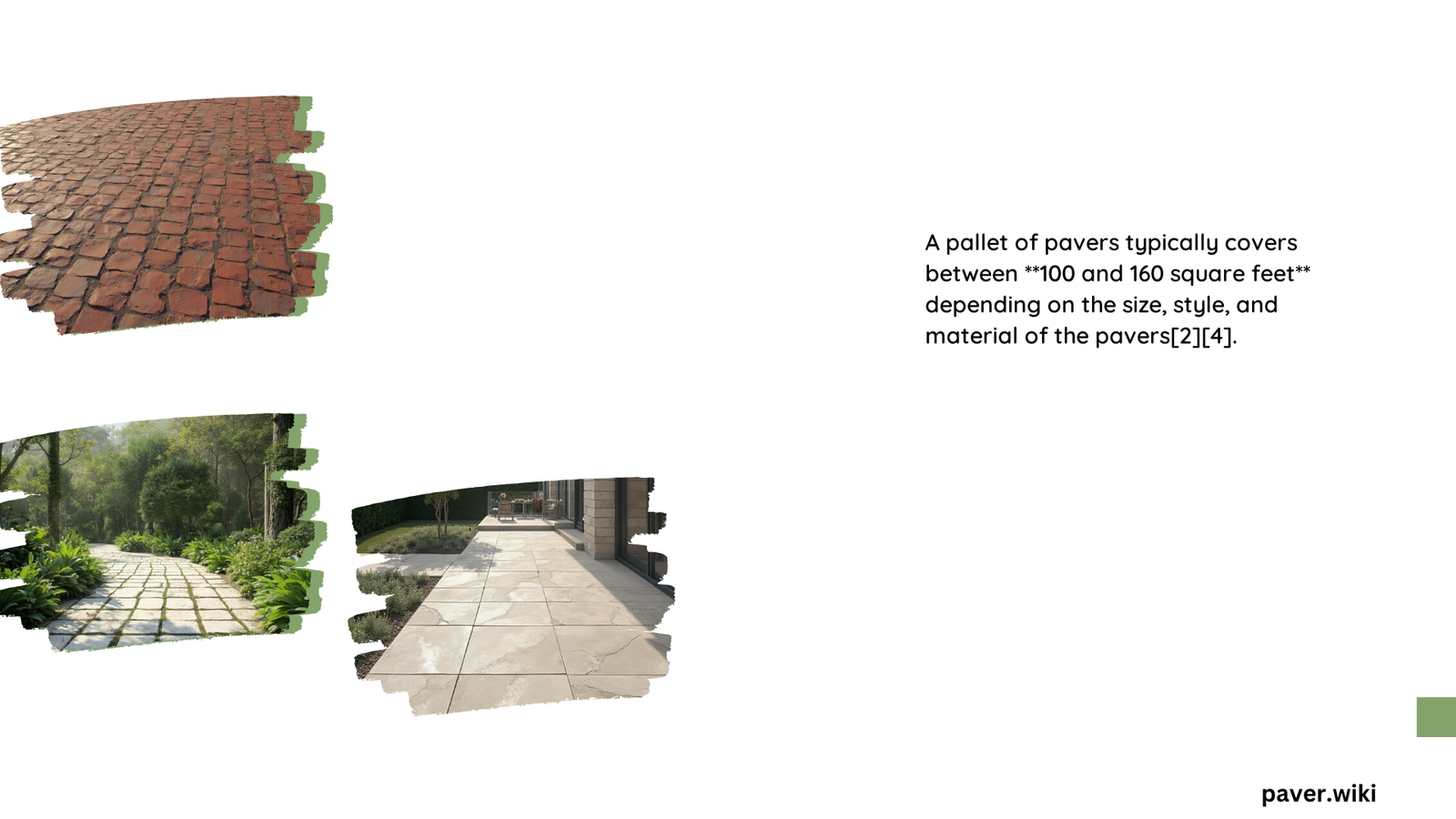The square feet per pallet of pavers varies significantly depending on the paver type, size, and manufacturer. Typically, a pallet of pavers covers between 56 to 120 square feet. Factors such as paver thickness, material, and installation pattern can affect the coverage area. Understanding these variations is crucial for accurate project planning and cost estimation in landscaping and hardscaping projects.
What Are the Standard Square Feet Coverages for Different Paver Types?
The coverage area of pavers per pallet varies widely based on the manufacturer and paver style. Here’s a breakdown of some common paver types and their typical coverage:
Belgard Pavers
- Bergerac – 3 Piece: 114 sq ft/pallet
- Cambridge Cobble – 2 Piece: 120 sq ft/pallet
- Catalina Stone – 1 Piece Rectangle: 112 sq ft/pallet
General Paver Sizes
- 6″ x 6″: Approximately 72 sq ft/pallet (288 pieces)
- 6″ x 9″: Approximately 82.5 sq ft/pallet (220 pieces)
- 12″ x 12″: Approximately 56 sq ft/pallet (56 pieces)
How Do Paver Dimensions Affect Square Footage Per Pallet?

The dimensions of pavers directly impact the square footage coverage per pallet. Larger pavers generally cover more area with fewer pieces, while smaller pavers require more pieces to cover the same area. Here’s a comparison:
| Paver Size | Sq Ft/Pallet | Pieces/Pallet |
|---|---|---|
| 6″ x 6″ | 72 | 288 |
| 6″ x 9″ | 82.5 | 220 |
| 12″ x 12″ | 56 | 56 |
As you can see, the 12″ x 12″ pavers cover less total area per pallet but use significantly fewer pieces, which can affect installation time and labor costs.
What Factors Influence the Square Footage Coverage of Paver Pallets?
Several factors can influence the square footage coverage of paver pallets:
-
Paver Thickness: Thicker pavers take up more volume, resulting in fewer pieces per pallet and potentially less square footage coverage.
-
Material Density: Denser materials like natural stone may result in fewer pavers per pallet compared to lighter concrete pavers.
-
Pallet Size: The dimensions of the pallet itself can limit the number of pavers it can hold, affecting total coverage.
-
Packaging Method: How tightly pavers are packed and arranged on the pallet can impact the total number of pieces and square footage.
-
Manufacturing Tolerances: Slight variations in paver dimensions due to manufacturing processes can affect the overall coverage area.
How Does Installation Pattern Affect Paver Coverage?
The installation pattern chosen for pavers can significantly impact the coverage area and the number of pavers needed:
- Straight Patterns: Generally require the least number of pavers and provide the most efficient coverage.
- Diagonal Patterns: Can require up to 10-15% more pavers due to additional cuts needed at edges.
- Herringbone Patterns: May require more pavers and result in more waste due to complex cutting requirements.
What Are the Weight Considerations for Paver Pallets?
Understanding the weight of paver pallets is crucial for transportation and installation planning:
- Concrete pavers (1-inch thick): Approximately 11 lbs/sq ft
- Concrete pavers (2-inch thick): Approximately 22 lbs/sq ft
- Brick pavers (2 ¼ inch): Starting at 22 lbs/sq ft
A typical pallet of pavers can weigh up to 4,800 pounds, depending on the paver size and thickness. This weight impacts:
- Transportation requirements
- Equipment needed for unloading and moving
- Structural considerations for storage areas
How to Calculate the Number of Paver Pallets Needed for a Project?
To calculate the number of paver pallets needed:
- Measure the total area to be paved in square feet.
- Add 5-10% for straight patterns or up to 20% for diagonal patterns to account for cuts and waste.
- Divide the total square footage (including waste) by the square footage coverage per pallet for your chosen paver.
Example calculation:
– Project area: 500 sq ft
– Waste allowance: 10% (50 sq ft)
– Total area: 550 sq ft
– Paver coverage: 100 sq ft/pallet
– Pallets needed: 550 ÷ 100 = 5.5 pallets (round up to 6)
What Are the Best Practices for Ordering Pavers?
When ordering pavers, consider these best practices:
- Always Order Extra: Add 5-10% to your calculated amount to account for breakage, cuts, and future repairs.
- Check Lot Numbers: Ensure all pavers come from the same production lot to avoid color variations.
- Verify Pallet Contents: Confirm the exact square footage and number of pieces per pallet with your supplier.
- Consider Delivery Logistics: Plan for proper equipment and access for pallet delivery and unloading.
- Storage Preparation: Ensure you have a flat, stable area to store pallets before installation.
How Does Paver Thickness Impact Square Footage Per Pallet?
Paver thickness plays a significant role in determining the square footage per pallet:
- Thinner Pavers (1-inch): Generally yield more square footage per pallet due to their lighter weight and smaller volume.
- Standard Pavers (2-inch): Offer a balance between durability and coverage, with moderate square footage per pallet.
- Thick Pavers (2.5-inch or more): Provide less square footage per pallet but offer increased strength for high-traffic areas.
| Paver Thickness | Approx. Sq Ft/Pallet | Relative Weight |
|---|---|---|
| 1-inch | 120-140 | Lightest |
| 2-inch | 90-110 | Moderate |
| 2.5-inch+ | 70-90 | Heaviest |
What Are the Environmental Considerations for Paver Pallet Usage?
When considering the environmental impact of paver pallets:
- Pallet Material: Wood pallets can be recycled or repurposed, while plastic pallets are durable and reusable.
- Transportation Efficiency: Maximizing pallet loads reduces the number of trips and overall carbon footprint.
- Waste Reduction: Accurate ordering based on square footage calculations minimizes excess material and waste.
- Local Sourcing: Choosing locally produced pavers can reduce transportation distances and associated emissions.
By understanding the square feet per pallet of pavers and related considerations, project planners and homeowners can make informed decisions, optimize material usage, and ensure successful paving projects.
